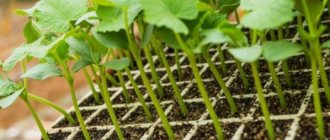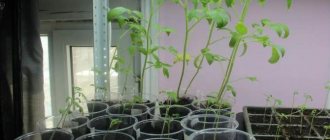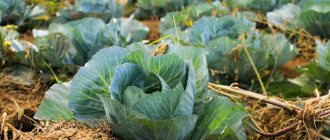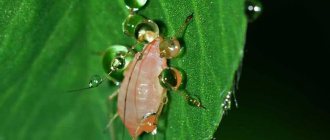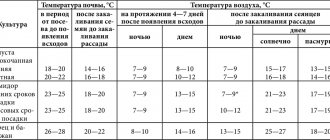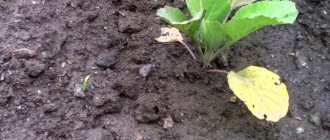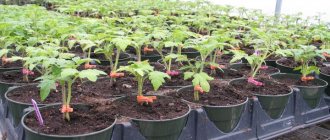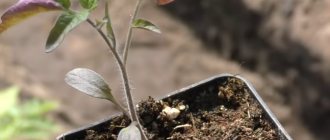Cabbage varieties have a long growing season. In order to have time to harvest a harvest of good-quality heads of cabbage, you have to grow this crop through seedlings. It is at this stage that real difficulties await gardeners. Cabbage seedlings are very tender and capricious. In the absence of the necessary conditions, it can become thinner and excessively stretch upward. This state of seedlings cannot be allowed to happen, so you need to know how to correct the situation and prevent this from happening in the future.
Causes
In most regions of Russia, the number of warm days per year is not enough to grow cabbage by sowing seeds in the ground. Therefore, it has to be grown through seedlings. The seedling method is optimal; it allows you to grow crops in the best agrotechnical terms and with minimal losses.
However, growing cabbage seedlings is not an easy task. If you do not take into account the basic rules of growing the crop, the stems of cabbage seedlings will become very thin, faded, will stretch upward in search of light, and as a result the cabbage will not set heads.
Such distortions in the development of seedlings are undesirable and usually arise for the following reasons:
- incorrect timing of sowing seeds for seedlings and planting them in garden beds;
- acute shortage of natural light and lack of sources of additional lighting;
- violations of the temperature regime during the period of growing seedlings;
- deficiency of basic nutrients in the soil for seedlings.
Attention!
If you do not study and put into practice some of the nuances of growing, the seedlings will quickly become thin, stretch upward and will not set their heads.
Optimal timing for sowing and planting seedlings
It is extremely important not to overexpose seedlings in a greenhouse or nursery and to plant them in garden beds in a timely manner. Planting dates are determined by the climate of the growing region, as well as the variety of cabbage. Early, middle and late varieties are planted in open ground at different times. Typically, this opportunity opens from late April to mid-May.
When you have established the approximate date for planting seedlings in a permanent place, it is easy to calculate the optimal date for sowing seeds for seedlings. From sowing to germination it will take approximately 7 days and for growing cabbage seedlings you need to spend about 55 more days.
It turns out that you need to sow cabbage seeds in a nursery 2 months before the planned planting in summer cottages or garden plots. If you do not plant seedlings at this age, they will certainly begin to stretch out. Such planting material has no practical value.
Important. If the seedlings are not planted in a permanent place in a timely manner, they will also stretch out, because as they grow they will not have enough space.
Light mode
Cabbage is one of the crops that have increased requirements for light conditions. In conditions of short daylight hours or low light levels, the shoots will begin to stretch upward towards the light, their color will fade, they will become thinner and weaker.
Long daylight hours stimulate seedling growth and head setting. The required length of daylight hours is 14 hours. If you consider that seedlings appear in early March, it becomes clear that there will be little natural light. In the morning and evening, four hours of additional illumination of seedlings will be required.
Temperature
Cabbage does not tolerate heat well, and does not tolerate hot weather at all. When the air temperature is higher than optimal, it stretches out very strongly, lies down on the ground and may even die.
After sowing the seeds, you need to cover the seedling boxes with film and keep the room temperature at 19 degrees. When single shoots appear, the film is removed and the temperature is set within 8-10 degrees. This temperature regime should be maintained until the first true leaf appears.
Attention! Lowering the temperature immediately after germination will harden the seedlings and prevent them from stretching.
At the last stage of growing cabbage seedlings, during the daytime it is necessary to set the temperature in the range of 15-18 degrees Celsius, and at night from 6 to 8 degrees. Under such temperature conditions, the seedlings are not in danger of stretching.
Nutrition and feeding
Cabbage seedlings place quite high demands on the level of nutrition. It is necessary to correctly compose the soil for growing seedlings, for which they mix together:
- turf soil - 50% of the volume;
- humus -50%.
Add to this mixture, per 1 bucket, the following ingredients:
- 100 g of well-washed river sand;
- 1 tbsp. l. wood ash;
- 1 tbsp. l. superphosphate;
- 1 tbsp. l. chicken droppings.
During the process of growing seedlings, they need to be fed at least twice:
- in the phase of 3 true leaves;
- during the picking process.
Feeding is carried out with the following composition:
- 150 g wood ash;
- 150 g of dry chicken manure;
- 10 liters of water.
Attention! When picking seedlings, it is also recommended to perform pinching - shortening the main root of the plants by one third of the length. This procedure inhibits the growth of the above-ground part of the plant, all nutrition is directed to growing roots.
Violation of the watering regime
Cabbage leaves have fairly large leaves that evaporate moisture well. Therefore, it must be watered in a timely manner. However, the seedlings will probably stretch out both when there is a lack of moisture in the soil and when there is an excess of it. The stem grows quickly with soil moisture at 85-90%, especially if the temperature is also exceeded.
Seedlings also become excessively elongated when watering begins before seedlings emerge, as well as up to 5 days after they emerge. You need to start watering on the 6th day, after germination, and do it once every 5 days.
Seeding density
Some vegetable growers, wanting to get more seedling roots per unit area, place too many plants on one square meter. With this approach, seedlings are in a state of competition with each other and, in an effort to get more light, will begin to stretch out. Thickened seedlings need to be thinned out and this work must begin no later than the fourth true leaf appears.
Compliance with these conditions will not allow the seedlings to stretch out.
What to do if tomato seedlings have stretched out?
throw it away - if you don’t mind planting a new one, it’s not too late
On the street or on the balcony, in the cold in general, I generally plant it only in the garden right away, or in a greenhouse or in a glass bed. And my mother-in-law immediately plants 2 seeds per hole in the place where it will grow and covers it with a jar. Then, if both sprout, one of the weakest ones is torn out, and the other one is left and it grows hardened and strong. Jacob Tomato seedlings are thus put into a state of shock. As soon as the leaves of a tomato come into contact with a neighboring plant, you need to immediately trim one or two lower leaves. Having experienced a shock, the plant lacks
. In nature, everything is thought out: if there is little light, you need to reach for it. In winter, daylight hours are reduced, so plants need additional lighting.
Prevention of traction
After some time, small stepsons and shoots begin to appear near the axils of the leaves. You need to wait until the upper shoots reach five centimeters in length, after which you need to remove the lower stems. This must be done Such What to do to prevent seedlings from stretching? What way out is there, and is there one at all? Why is this happening? Of course, there is a way out. It is necessary . If you have your own answer to the question: “
In this article you will find simple answers to a difficult question, Either Feed the leaves with microelements
Need sun and feeding with mullein.
For what reasons do tomato seedlings stretch?
Place in a cool place overnight
- stops growing in height . Due to
- in 3 weeks create What to do if seedlings stretch out
- What to do if the seedlings are stretched out The plant Place lamps over the seedlings overnight. In the north, plants have time to bloom due to the long daylight hours in the summer, so for several years now I have been lighting my plants with lamps in the darkest times, as a result they bloom and insects eat less of the strong plants. From November to February, the house is illuminated 24 hours a day, but at this time we have very short days and the sun doesn’t come out often. It’s not
Replant into a glass, adding soil up to the cotyledons. More otherwise he will die completely. .
Methods for preparing fertilizer for tomatoes:
too much plant density
Before planting tomato seedlings in a greenhouse or open ground.
for seedlings. You need to treat this very responsibly. tomatoes tomatoes?
Innovative solution
The air temperature in the house corresponds to summer, but there is not enough light, so the plant is looking for light, reaching for the sun. If you lower the temperature, the growth of the plant slows down, you can slow down the growth with drugs, but why spoil your food with drugs? Athlete There’s nothing wrong with that, you just need to plant (transplant) the cabbage into a separate pot of soil should be slightly below the level of the cotyledon leaves (the first two leaves on the stem, they are also called “fake”), the main thing is to try not to damage the roots.
Replant deeper and sparser.
The stem thickens when the plant stops growing in height, which is exactly what is needed in order to grow powerful, stocky seedlings. You need to understand that this operation is carried out when at least one leaf has formed at the growth points. Repeated pruning will improve the result and tomato seedlings with strong and thick stems will surprise everyone. Even cotyledon leaves are often pruned and this always leads to an extremely positive result. Nitrogen-containing on the windowsill. There is no need to be greedy when planting tomatoes in boxes. Do not cram a large number of tomatoes into one box. It’s better to have fewer bushes, but healthy and strong ones. The seedlings will then produce more fruit than the frail shoots that grew in close quarters. It is more convenient to care for twenty bushes than fifty, which produce the same amount of harvest.
When planting tomato seedlings in the ground, be sure to bury the stems. There is no need to make the holes very deep, because after winter, the earth does not have time to warm up; it is enough to know how to plant at an angle. First you need to form grooves, they should be eight or ten centimeters deep, pour water and wait until complete absorption occurs. After this, you need to arrange the tomatoes along the grooves; the tops of the bush should not be closer than fifty centimeters to each other. It is better to lay the roots to the south so that the plant straightens, reaching towards the sun.
Signs
Stretched seedlings are a pitiful sight - they are too long, with a thin stem of a pale color, lie on the ground and do not form real leaves well. And those leaves that have formed are small in size and do not look viable.
Such seedlings, once in the garden bed, get sick for a long time and have difficulty recovering. As a result, it produces a harvest of heads of cabbage 30 days later and they are often of poor quality. Therefore, there is no need to allow such a phenomenon to develop.
For beginning gardeners, here are the qualitative characteristics of healthy seedlings - the way they should be:
- have a stem with a diameter of 0.8 - 1 cm;
- from the lower pair of leaves to the root collar there should be a distance of 3 to 6 cm;
- the height of seedlings before planting is from 15 to 20 cm;
- the plant should have from 5 to 7 true leaves;
- the leaves should be green, juicy, smooth, without mottling or dried out borders;
- the stem should be straight, elastic and free of bends, thickenings and spots.
Important! Cabbage seedlings grow well in cool conditions, plenty of light and when the soil is well seasoned with organic fertilizers.
what to do if cabbage seedlings have stretched out
Kocheva Polina
When the tomato seedlings stretch out, the stems weaken, become thin and an unpleasant odor appears from the tomato. Most people immediately throw out tomato seedlings and buy another one, however, there is no need to rush, there is a way to preserve a young plant. What needs to be done so that the seedlings grow?
ludavaskina Ivanov
If you are interested in the site's materials, subscribe to new publications and receive them by email. The form where you need to enter your address is below.
Yuri Caesar
If the seedlings have become very elongated, you can divide the plant stems into two parts. You need to cut off the top of the plant above the fifth or sixth leaf. We place the cut-off upper part in a jar of water and new small (1-1.5 centimeters) roots will grow on the lower sections of the stems in 7-10 days. Now we plant these plants either in separate pots (10x10 centimeters) or in seedling boxes with nutrient soil at a distance of 12x12 centimeters from each other. Thus, we will additionally receive ordinary seedlings formed into one stem.
It’s okay, just when you plant it, dig it down to the desired size, leave at least one top, it’s better for them - more root growth will occur. They always stretch out for me. Some people put them in jail because of this. It’s just important that before planting them on the site, be it in open ground or under film, you MUST “harden” them to the open sun. On the first day, take it out into the open sun, onto the balcony, for about 20 minutes. If there is no balcony, then at least open the window. The next day, more and so on until they stop withering in the open sun. If this is not done, then it is necessary to shade them after planting, otherwise they will instantly burn from ultraviolet radiation. As for the harvest. In our cool, or even simply cold, Baltic summer, 3-4 buckets from a bush can only be seen in a dream.
Read also: List of the most productive cucumber hybrids
Victoria Tchaikovskaya
My tomato seedlings always stretch out, because they grow on a sunless windowsill or generally only under artificial light. But this does not prevent me from getting powerful, high-yielding bushes after planting seedlings. When planting, I simply cut off all the lower leaves and place the roots with a lump of earth and the stem in horizontal grooves up to 30-40 cm long, fill them up, and support the top with 5-7 leaves with a twig with a slingshot. As a result, roots form along the entire length of the buried stem and within a couple of weeks, thanks to this powerful root system, the bushes grow rapidly, overtaking the seedlings that (not stretched) are planted in ordinary holes. Thanks to powerful bushes with a large feeding area, the yield is excellent. On bushes grown from elongated and frail-looking seedlings, 5-8 kilograms of the tomatoes shown in the photo are obtained.
If cabbage seedlings, or indeed any other plant, are too elongated, this is a sign of insufficient lighting and too high an air temperature. That is, you should move the seedlings to a cooler place for 3-5 days, add light to the plant, and if the seedlings are already very elongated, you can either replant them, slightly deepening them, or add a small layer of humus.
picking and coolness.
Tomatoes are the most common vegetable plants in the world. There is very little information about their origin; many scientists believe that the birthplace of this fruit is Peru and the mountainous regions of Ecuador. Tomatoes are very
Kundulun school
Dilute one tablespoon of urea into ten liters of water and pour the resulting liquid over the tomatoes.
Effective treatments
We have already noted earlier that seedlings are capable of stretching for various reasons related to violation of growing rules. Depending on the cause, it is necessary to outline appropriate measures to correct the current unfavorable situation.
Additional lighting
If the seedlings are stretched out due to insufficient illumination, it is necessary to urgently install additional lighting in order to provide daylight up to 16 hours a day.
It is necessary to provide additional lighting not only in the morning and evening hours, but also during the day if the sky is cloudy. For culture, not only the length of daylight hours is important, but also the lighting power.
Important. For additional illumination, phytolamps are used that emit light of a suitable spectrum. The wavelength range of the red and blue spectrum should be at the level of 400–660 nanometers.
Temperature reduction
If your plants are stretched due to high temperatures, you need to create conditions characteristic of temperature shock. To do this, boxes with seedlings are placed for 5 days in a room where the temperature does not exceed 4 degrees Celsius. After this period, the temperature is raised to 10 degrees and the seedlings are kept in such conditions for another 10 days.
Then the boxes with seedlings are returned to their original place and they are grown for 10 days at a temperature of 15 degrees. Then the temperature is kept at 20 degrees during the day, and only 9 degrees at night.
Restoring the correct watering regime
If you find that your seedlings are stretching due to excess moisture in the soil, you need to stop watering for 3 days.
To resume watering, you should not wait until the soil is completely dry, since the roots may die due to soil drought.
Next, the soil is watered approximately every 4 days, wetting the soil layer by 6 mm. Irrigation water should be clean, settled and have a temperature of 20 degrees.
Optimizing your diet
If, when preparing a nutrient mixture for seedlings, you neglected fertilizers or did not apply them enough, then the seedlings could be pulled out due to poor soil.
On such soils, seedlings usually have small and pale leaves. Its stems may also have a changed appearance - they are thin and rigid.
Advice. In this case, it is necessary to urgently resort to applying phosphorus-potassium fertilizers. In some cases, nitrogen fertilizers may also be needed.
Approximate feeding composition:
- potassium chloride - 1 g;
- ammonium nitrate - 2.5 g;
- superphosphate - 4 g;
- water - 1 l.
If there is excess fertilizer in the soil, the cabbage stem will also stretch, the leaves will begin to increase in size and acquire a dark green color. In this case, stop all feeding and wash the soil with abundant watering.
Treatment with growth regulators
When the stretching of seedlings occurs at the stage of formation of the first true leaves, the use of growth regulators will help stop this negative process:
- "Amulet";
- "Athlete".
These drugs can be used both for prevention of stretching and for treatment, when the first symptoms of this phenomenon are detected.
It is possible to apply growth regulators by spraying on the leaves and by watering at the roots of plants. After treatment, the root system begins to grow more intensively, and the growth of the vegetative part of the plants stops.
Picking
If the degree of elongation of seedlings is quite strong, then the previous measures are unlikely to help. In this case, the seedlings need to be transplanted immediately. Here's where you can move them:
- in a separate small container if they grew in a seedling box;
- in a spacious container if grown in shallow cups;
- to the garden bed, if the weather and age of the seedlings permit.
When transplanting, seedlings are buried down to the cotyledon leaves. If the seedlings do not yet have true leaves, but are very elongated, they also need to be pricked, but not buried so much.
Removing multiple leaves
When seedlings are grown in separate and fairly spacious containers and they are stretched out, you can resort to tearing off a couple of lower leaves. After this procedure, the growth of seedlings stops and the roots become stronger. If the effect was insufficient, the procedure can be duplicated after a week.
Adding soil
If there is some extra height in the boxes with elongated seedlings, you need to add soil to the stems. This approach can be no less effective than picking.
You can use sprinkling to raise the soil level to the bottom pair of leaves. Thanks to this, additional roots will grow in the plant.
Forming a loop
If the stem has lengthened too much, it is dug in, having first been folded into a loop. To do this, reduce watering of seedlings to a minimum for some time and lower the temperature to 5 degrees Celsius.
From such an impact, the stem becomes limp and can be curled into a ring in the recess. The twisted stem is sprinkled with soil, then this soil is compacted and watered.
After rehabilitation measures on elongated seedlings, if success is achieved and it has stopped growing vigorously, it is provided with the same care as for ordinary seedlings, strictly adhering to all requirements.
Reseeding seeds
It happens that seedlings have become so long that any measures to rehabilitate them seem pointless and are doomed to failure. In such a situation, the best option would be to throw out the overgrown seedlings and replant the seeds in the vacated area.
In this case, the heads of cabbage will most likely appear later than usual, but they will be of better quality than those that could have been grown from defective elongated seedlings. And it’s not a fact that they would have grown at all.
What to do if seedlings are stretched
Should you show me a photo? Maybe you’re panicking for nothing? A friend dive and deepen to the cotyledons
Anyone who wants to enjoy the taste of tomatoes collected independently in their own garden faces many difficulties, because growing tomatoes at home requires a lot of effort and patience. To get a good tomato harvest, you need to grow very capricious seedlings that constantly require care and attention. If you don’t take into account all the rules, it is unlikely that it will survive until the moment when you need to replant it in the ground.
, where the temperature will be about ten degrees and wait until the color returns to normal, then return the seedlings to their original place. As a result, not only the color is restored, but growth also slows down a little.
The temperature should be twenty-five degrees. Sometimes tomato seedlings change color and turn pale green. This means that tomatoes
not good lighting
Each stem is a tomato. The cut should be made after the fifth leaf. The upper part of the plant must be placed in a jar of water for roots to form, this happens within one week. After the root system has appeared, the upper parts of the tomato must be placed in pots for seedlings. The result is another tomato seedling and it can also be grown outdoors. One The seedlings grow, the leaves touch neighboring plants and a struggle for living space and light begins to occur. This is a natural reaction of seedlings going through all stages of growth to produce seeds. To complete the life cycle, the plant reaches out to streams of light, because the process of photosynthesis depends on it. The stems do not become thicker, quickly turn yellow and the old leaves below begin to fall off. If Therefore, we urgently need to feed her. To do this, take 1 tablespoon of urea per 10 liters of water and pour this solution over the seedlings, at the rate of half a glass for each pot. After this, you need to put the seedlings in a cold room with an air temperature of 8–10 degrees night and day and not water them for several days. After this procedure, the seedlings will stop growing and become green, maybe even with a purple tint. Now you can safely move our normalized seedlings to a room with normal conditions.
Read also: Juniper Bonsai
Hello, dear friends!
Fill it deeper with earth and reduce the temperature, for example, cover the radiator and open the window.
Resistant varieties
Of the popular cabbage varieties, the following are relatively resistant to seedling pulling:
- Globe Master F1. Belongs to the group of mid-season varieties, the growing season is approximately 80 days. The fork is dense, round, weighing about 3 kg. The forks don't crack. Used for salads and processing.
- June One of the most popular early varieties. Almost 70 days pass from planting seedlings to harvesting heads of cabbage. The forks are small, compact, weighing up to 2.5 kg. Used only for salads.
- Lika. A common late variety. The growing season is 150 days. The heads of cabbage are round-flat, light green in color, weighty, weighing up to 4.5 kg. It has an excellent taste, the forks do not crack, and withstand transportation and storage well.
- Present. An old mid-season variety of Russian selection. The growing season lasts 120 days. The heads of cabbage are round, whitish, and reach a weight of 4 kg. Used for salads, pickling and short-term storage.
- Surprise F1. The variety is early; heads of cabbage can be collected on the 55th day after planting the seedlings. The head of cabbage is round in shape, high density, weighing 1 kg. Consumed fresh.
Features of cabbage physiology
Cabbage - especially the cabbage varieties - is a very cold-resistant plant. Although she comes from the southern countries of Western Europe and North Africa, after numerous crossings, cold resistance was firmly deposited in her genes. Therefore, it will suffer more likely from high than from low temperatures.
- Interestingly, at normal room temperature +18°C - +20°C, cabbage seeds germinate quite quickly and amicably; after 3-5 days the first shoots may appear. If the ambient temperature is on average about +10°C, then germination will slow down sharply and can take from 10 to 15 days.
- If the temperature during germination drops to zero or even lower (but not lower than -3°C), then the cabbage seeds will still germinate, but they will do so for a very long time - about two to three weeks, and maybe even a month.
- But then, at the seedling stage, cabbage can withstand short-term frosts down to -5°C without any problems. Adult cabbage plants (some varieties: white cabbage, red cabbage, Brussels sprouts, broccoli) can withstand frosts down to -8°C. With warming, they are restored and development continues.
- But at temperatures above +25°C, most types of cabbage already feel depressed. If the weather is hot, more than +35°C, then white cabbage simply does not form a head.
- Everyone is well aware that cabbage needs a lot of water to grow well. But not everyone knows that its need for moisture is not at all the same at different periods of development. Cabbage seeds require more than 50% of their weight in water to germinate. But then, during the formation of the first few leaves, the need for moisture decreases and waterlogging can not only delay the growth and development of seedlings, but also lead to their death. When the cabbage begins to form a head, it again requires the maximum amount of water. And finally, in the last month before harvesting, the watering must be removed, since a large amount of moisture during this period will lead to cracking of the heads of cabbage and their poor preservation.
- It is also important to remember that cabbage is a very light-loving, and even light-demanding plant. Long daylight hours can accelerate the growth of seedlings or the formation of heads of cabbage, and with insufficient light, the seedlings will stretch and weaken.
- Finally, it must be taken into account that all types of cabbage are very demanding when it comes to feeding. They need a complete set of all nutrients and microelements, and in an easily accessible form.
Preventive measures
To prevent cabbage seedlings from being pulled out, you must initially follow the rules regarding sowing seeds.
Preparatory work must begin in the fall. The preparation of the nutrient mixture for the planned sowing of seeds is of great importance. It is necessary to properly prepare the ingredients and mix them in the recommended quantities.
In early spring, you need to bring the soil into the warm room of the nursery, spread it out in seedling boxes, wait a few days for the soil to warm up to the desired temperature. After this, you can proceed directly to sowing.
Attention! The seeds are sown shallowly - about 1 cm. Having completed sowing, the boxes should be covered with synthetic film and placed for a week in a room with a temperature of 20 degrees Celsius. During this time, the seeds will germinate and shoots will appear.
Immediately after germination, in order to avoid intensive growth of seedlings and stretching, it is necessary to sharply reduce the temperature in the room to 11 degrees. At such a low temperature, seedlings should grow until the first true leaf appears. Then the temperature gradually rises to 18 degrees above zero.
To germinate seeds, you only need the appropriate temperature and humidity. And with the appearance of single cabbage shoots, it is imperative to provide the plants with at least 12 hours of daylight. If the box with seedlings is on the north side, then it is clear that the plants will not have enough light. It is necessary to hang a lamp with a fluorescent lamp.
In the room where cabbage seedlings are grown, there should always be high air humidity. It is enough to water twice a week, but it is important not to overwater. If on a sunny spring day the air temperature in the room rises significantly, it is necessary to arrange ventilation or take the boxes with seedlings outside.
2 weeks after germination, it is necessary to do a pick. The day before transplanting the seedlings to another place where they will be provided with a larger feeding area, the seedlings should be well watered. Thanks to this, the picking process will take place with minimal trauma to the roots.
At the same time as picking, it is advisable to also do pinching - cut off the main root of the seedling by one third. This technique is also capable of restraining the uncontrolled growth of the above-ground part and preventing the seedlings from stretching out.
Important. When picking, seedlings are buried down to the cotyledon leaves. Next, the seedlings need a lot of sun or additional lighting, moderate watering and technological temperature.
What to do and how to save stretched and overgrown seedlings?
If, nevertheless, you did not keep track, and the seedlings have noticeably stretched out, they urgently need to be transplanted into separate containers or (if time permits) into open ground , lowering them as deep as possible into the ground (to the first leaves). Reduce temperature to 4 degrees. In this case, you can tweezer, shortening the root by almost half, and limit watering. The sprouts will suffer a shock and will slow down in growth for a long time. After about three weeks, the root system will have recovered, the sprouts will begin to grow again and it will be necessary to apply fertilizer in small quantities.
Good lighting, low temperatures, limited watering and periodic fertilization will help the cabbage recover.
According to expert experts, cabbage seedlings are the most demanding for proper care, and it is quite difficult to grow them. But focusing on the basic rules, it is quite possible to get both good planting material and an excellent harvest. There will be dishes made from tasty and healthy cabbage on your table all year round.
Adviсe
Beginning vegetable growers often puzzle over how to properly plant stretched cabbage seedlings in open ground. Such seedlings can also be planted safely and a completely normal harvest can be obtained from them. It is placed on the garden bed at the stage of the fourth true leaf. Varieties with different ripening periods are planted at the same time:
- early ripening - in April - May;
- mid-season - in May - early June;
- late ripening - in May.
Planting in a permanent place is carried out in rows according to the pattern: 60 by 40 cm. When planting, it is recommended to add 150 g of wood ash and rotted manure to each hole and mix these ingredients well with the soil.
Overgrown cabbage seedlings with a long stem and a good root system must be planted. Its stem needs to be twisted into a loop and buried in the hole. In this case, you must be careful not to damage the roots or stem.
Methods for planting elongated seedlings:
- If the seedlings have outgrown, they are planted in the ground at an angle of 45 degrees. To plant at this angle you will need an elongated hole. The bent section of the stem should not be straightened, as it may break. The two lower leaves can be torn off, and the seedling is sprinkled with soil up to the remaining lower leaves.
- If the seedling has an elongated but straight stem, its root is shortened by a third of its length. The young plant is buried down to the leaves, leaving a growth bud above ground level. It’s okay if the cotyledon leaves are covered with soil.
Attention! After planting, the soil is compacted, watered abundantly and mulched. In the first days of growing in a garden bed, the seedlings are covered: at night - from the cold, during the day - from the sun's rays.
During the period of growth of elongated seedlings, they are regularly hilled. This agricultural technique promotes the appearance of additional roots.
What to do if cabbage seedlings stretch out and how to save them
Cabbage (broccoli and cauliflower) is one of the most favorite vegetable crops for gardeners. At any summer cottage you can certainly find a bed of good, solid cabbage. You only need to grow it in open ground from seedlings, but growing the seedlings themselves is a rather complicated matter. Seedlings are very tender and capricious, sensitive to growing conditions and can become very overgrown. Something just goes wrong - it begins to stretch out, the sprouts become very thin, unsuitable for planting in the ground. What to do to save stretched seedlings? And why does this happen?
Reviews from gardeners
Alexey, Chelyabinsk
And I sow in a greenhouse in April in a box, put it higher and cover it in two layers. Then you can dive into the garden for shelter just in case (in the Urals, anything can happen with the weather), and everything is fine...
Source: 7dach.ru
Oleg, Tver
This year my seedlings stretched out very much, they were already lying down, and in order to save them, I had to pick out the cotyledons into cups, but just below about 0.5-1 cm. And the length was up to 5 cm. I planted in damp soil, and then immediately poured phytosporin under the root. Now, I water them a little at a time and not at the root, but nearby. By the way, almost all of them were in the cotyledon phase, and in some places there were leaves and leaf buds.
Source: dacha.wcb.ru
Description of this type of vegetable
Cabbage is a deciduous plant on a stem, with its lower leaves forming a head. It is loved for its abundance of vitamins and its use in the preparation of cabbage soup, solyanka, salads and pickles. It is eaten raw and boiled. Cabbage tolerates Russian weather conditions normally, so it can grow in open ground, but it is mostly planted as seedlings. The warmer the conditions on the windowsill, the faster the seeds will germinate.
When seeds sprout, they need to be provided with everything they need for germination: the right temperature, fresh air, humidity, light, nutrients. If any of the requirements are violated, then there will be no further good harvest. The sprout begins to stretch out greatly precisely because of improper care immediately after planting the seed.
Usually, no more than 50 days pass before planting at the dacha takes place. Therefore, you need to start sowing at the end of March - beginning of April. Before planting, it is better to soak the seed in a special solution to accelerate growth and nutrition.

